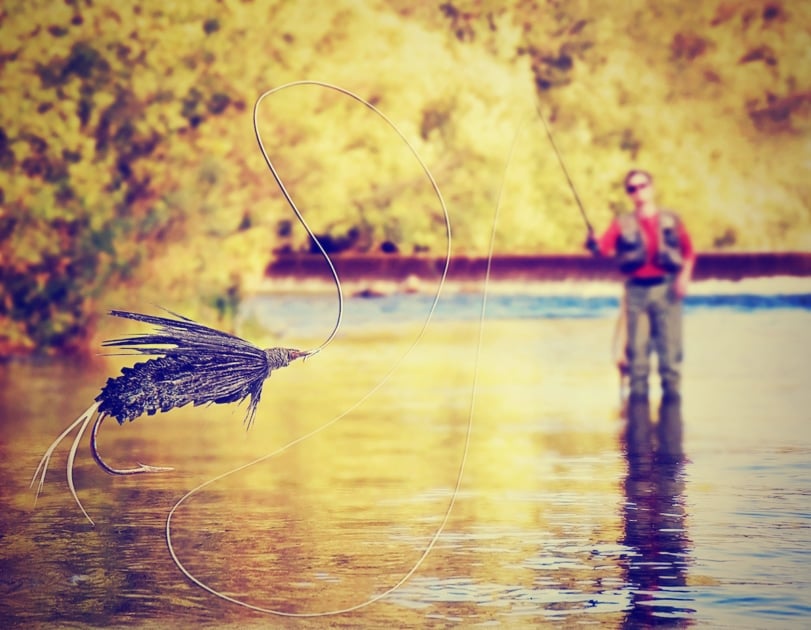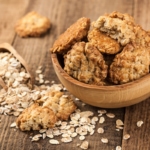Fly Fishing: A Beginner’s Guide
These expert tips give will help you get started with fly fishing. It could become your new favorite outdoor sport!

After the release of the 1992 film A River Runs Through it, based on the novella by Norman Maclean, the art of fly fishing was introduced into the public consciousness for essentially the first time. Immediately after the movie’s release, interest in fly fishing doubled. America’s love affair with the sport had officially begun. And with good reason. Anyone who fly fishes will tell you, the sport is magic. To be out in the fresh air and one with nature is exhilarating, meditative, and will even give you a workout. If you’ve ever thought about giving fly fishing a try, you’ve come to the right place. We’ve checked in with a master fly fisherman to break down the essential elements, and what you’ll need to get started. It could become your new favorite outdoor sport!
Be sure to check our Fishing Calendar for the best days to cast your line!
How Is Fly Fishing Different From “Regular” Fishing?
Whereas other styles of fishing involve casting a baited hook and sinker, or artificial lure tied to the end of a light line, fly fishing is the art of casting a thicker, heavier line into the air, which then drags along the water’s surface with an almost-weightless fly. That “fly” is what gives “fly fishing” its name. It’s a light, artificial lure at the end of the fishing line that fish are attracted to. A fly can be an imitation of a fly or another insect, and will differ in size and shape depending on what you’re hoping to catch.
Additionally, the idea behind fly fishing is almost a game, to trick fish into thinking the fly at the end of the line is the real deal; many people who fly fish are looking to challenge themselves with a trickier form of fishing rather than trying to catch as many fish as possible. That’s not to say you won’t catch fish, because you will.
What are the main types of flies?

Flies for fishing are generally composed of a mixture of feathers and fur, tinsel, wool, and/or assorted synthetic materials, carefully tied to a hook with specialty threads. Flies often resemble a winged or terrestrial insect, a small baitfish, or some other creature that fish such as trout, bass, and salmon like to eat.
Types Of Fly Fishing Flies
- Streamers which are usually abstract representations of baitfish.
- Dry flies float on the surface like winged insects.
- Wet flies go below the water’s surface, with patterns that look like drowned mayflies. This category also includes salmon flies, which are colorful, often elaborate, abstract flies tied with exotic materials. To some people, these represent the pinnacle of the art of fly tying.
- Nymphs mimic nymphal forms of aquatic insects.
- Terrestrials such as ants, beetles, and grasshoppers.
- Saltwater flies which can imitate a wide variety of small fish, shrimp, eels, crabs, and other seagoing fish foods.
What’s the difference between bait casting and fly casting?
Bait casting and fly casting require very different techniques. They also require different hardware to deliver their payloads to the fish. Bait casting tosses the lure into the water where it will sink, while fly casting requires a bit more finesse so the fly’s movements are almost dance-like on the surface of the water. It requires using the shoulder, arm, wrist, and rod to control a loop of specially coated line, and leading it on a graceful path that allows it to lightly drop onto the water. This is called “presenting the fly.” Then, it is either allowed to drift into an area where fish are feeding or made to move through the water to mimic live fish food.
What do I need to get started?
Getting started with fly fishing requires a beginner to procure some specialized tackle, gear, and clothing. In addition to all the “stuff,” there’s some important skills to acquire. You can get these from an experienced angler willing to teach you, or by taking classes. It will also require some home study; and backyard practice can certainly make the learning curve easier and more enjoyable.
5 Beginner’s Steps To Fly Fishing

The amount of information and skill involved to becoming an accomplished fly fisher can seem daunting, but we can get you started learning the rewarding sport of catching fish on the fly with these five beginner’s steps:
Step 1 – Choose A Rod, Reel, And Line
You’ll have to choose a fly rod, reel, and line combo that’s appropriate to the type of fish you want to catch, whether it be pan-sized brook trout from a quiet mountain stream, salmon or steelhead from a large river, bass or trout from your favorite lake, or any number of species of saltwater fish from a boat on the ocean. The gear for each quarry and the flies used will differ depending on the fish.
Here is where you must turn to your local outfitter for help. Explain that you are a beginner and would like a “budget combo outfit that includes, rod, reel, backing, line, and leader” (no need to break the bank when first starting out).

Let’s assume that you’re after freshwater trout from an inland brook, stream, or river.
A good all-around freshwater outfit for trout starts with an 8 foot to 8 and-a-half foot “size 5” fly rod. You don’t need to worry about size numbers at first, except to understand that the bigger the number, the bigger the fish. A 5-weight rod is a middle-of-the-road fly rod, perfect for most trout (a 1- or 2-weight rod is considered a highly specialized tool for small native brook trout in a tiny spring creek).
Your fly reel will be matched to your rod and line size, and will be filled partway with some braided nylon backing. This backing is not used for casting, but to give you extra line for when you’re fighting a powerful fish that has taken your fly and run with it, dragging your fly line off the spool. One of the most exciting experiences in the sport is having a fish “run into the backing.” It means you have quite a challenging fight ahead of you!
Your outfitter will tie the backing to the actual fly line, which you will use for casting, and will also be matched to your rod and reel (see note below). Fly line is thicker than the backing, has a special slick coating allowing it to pass easily through the rod guides, as well as float or sink, and is tapered to assist in casting it. Fly line will usually be in a high visibility color, easy to see. But at the end, is a fly line leader, made of material designed to be invisible in the water. This is less likely to spook wary trout, and is what you’ll tie the fly to.
A note about fly reels:
It matters whether you are left-handed or right-handed. Right-handed anglers will hold the fly rod in their right hand, and manage the fly line and retrieve with the left. The fly reel is seated near the butt of the rod, aft of the (usually cork) grip, and is always oriented toward the ground. Your “line hand” so called because you are always holding onto the fly line with that hand. All fly reels can be switched from left- to right-handed retrieve. If you are a lefty, be sure to tell your outfitter.
Step 2 – Get An Inexpensive Fly Box With An Assortment of Flies

For trout fishing, choose an assortment of flies appropriate to the water you will be fishing. Again, your outfitter or an experienced fly fisher can help you out. It’s good to start with a few traditional attractor patterns. Dry flies, such as the Adams, Elk Hair Caddis, and the Royal Wulff are essentials; as are some buggy looking nymphs, such as the Bead Head Hare’s Ear, the Prince, and the “Brassie.” One or two streamers such as the Mickey Finn, Black-Nosed Dace, and the Muddler Minnow are classics, as well. And finally, pick up a couple of sizes of a “standby fly” known as the Wooly Bugger—a shaggy classic sub-surface fly proven to produce ferocious strikes. Then ask your outfitter for a budget fly box with silicone or foam inserts to hold your flies.
Step 3: Get The Tools Of The Trade
Essential stream-side tools for the fly fisher are:
- Hemostats – for removing flies from the jaws of the fish you catch.
- Nippers – similar to nail clippers for cutting monofilament leaders.
- Tippets – the very thin mono at the end of the tapered leader which attaches to the fly. During a day of fishing, this thinnest part of the leader requires replacing. So you’ll want to carry a spool of 5x tippet to repair the last several inches of your leader.
- Fly floatant – This is a waxy paste that you rub onto a dry fly and leader so it floats high in the water.
- Landing net – the net you’ll use to scoop up your fish. No need to buy the most expensive net as a beginner, but choose one that’s lightweight and sturdy, with a wooden frame and rubberized mesh. A magnetic release net holder that will attach to your fishing vest is a good idea.
- Creel (basket) – if you will be eating your catch rather than releasing it, your creel will keep your fish cool during transport to the skillet. A utilitarian canvas creel with a vinyl liner does a fine job.
- Knot-tying “cheat sheet” – a printout of diagrams of the knots you will need to tie as a fly fisher. Even though you bought a rod and reel combo that’s been rigged up for you, it’s good to learn how to tie the basic knots for yourself. There are videos online that will teach you how, right from your phone. There are also pocket-sized waterproof knot books you can carry in your vest.
Step 4: Wear The Proper Clothing

You will need a hat with a brim, or a baseball cap, polarized sunglasses, a fly vest (short length) or a fishing shirt with plenty of pockets, stocking-foot chest waders, and wading boots. Some fly fishing vests are pricey, so as a beginner, just opt for utility.
Waders are among the most expensive items the beginner needs to acquire. In the warm weather, you can “wet wade” with nothing more than shorts an old pair of sneakers, but waders will keep you dry and comfortable, protect anything in your pockets (think phone and wallet), and they certainly make the ride home more pleasant than wearing wet shorts. Shop around. Look for breathable, stocking-foot waders with good customer reviews. Avoid the cheapest vinyl waders, or those with the boots built in. Make sure they fit you and are comfortable. For wading boots, shop sales, outlets, look for lightweight, comfortable boots with studded felt soles. Depending on the style of waders, you may require accompanying gravel guards which, as the name suggests, prevent mud, sand, or gravel from getting into your wading boots. One essential item you need for wading is available for free—a wading staff, otherwise known as … a stick. It can provide balance in moving water and when there are slick rocks underfoot.
Step 5: Learn Basic Fly Casting
As with knot tying, there are plenty of videos on fly casting online. You’d be surprised how much you can learn from a video. But the best way to get a feel for the motion and rhythm is to get a lesson from an experienced fly fisher, and practice in your backyard. Use an old fly (with the hook cut off with wire cutters) for practice. Fly casting is all about precise movements of your arm and wrist, which cause the rod to flex and transfer momentum to the line.
The most important skill to master is the variable application of power to the casting strokes, and the abrupt stopping of motion, which allow you to control loops of fly line as they travel back and forth through the air behind and in front of the angler.
After the fly lands, the next skill to pick up is called “mending” the line. This is a method of keeping the fly floating downstream in a natural way. It’s mostly intuitive, using flicks of the rod to lift the fly line slightly off the water and toss it upstream of the leader. If the fly line starts dragging the fly unnaturally, it’s time to lift the line off the water and cast again.
Now, Let’s Go Fly Fishing!
The best way to master these techniques is to go out and try them. Ask questions, surf the web, and take advantage of local fly fishing enthusiasts. Expect to lose some flies in the trees at first, and be ready to have the wind tangle and tie knots in your leader, but it won’t be long before you start to be able to put the fly exactly where you want it. You’ll drift it in front of a hungry trout’s nose and see the splash of a strike, and then you’ll be just as hooked as that first fish!
Good luck, or in the words of traditional fly fishers, “tight lines!”

Edward Higgins
Edward Higgins is a freelance writer, artist, home chef, and avid fly fisherman who lives outside of Portland, Maine. He studied at Skidmore College and Harvard University. His article 10 Best Edible Insects appears in the 2020 Farmers' Almanac.











